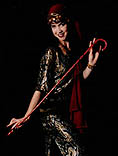|
| |
Raqs Al Assaya
|

Lorelle
with cane
|
|
Raqs al Assaya,
the Egyptian women’s cane dance, is said to have developed as an
imitation of tahtiyb, the men’s martial arts dance.
|
|
Tahtiyb originated
Upper Egypt or the Said, which is in the south of Egypt.
Traditionally in the Said, men carried long sticks (asa) as
weapons, and the male stick dance evolved out of displays of combat
skills using these sticks. A tahtiyb performance consists of the men
acting out a mock conflict; striking the ground or each other’s stick,
circling the sticks above their heads and performing hops and jumps.
|
|
The female version
is more lighthearted and flirtatious and the canes (assaya) are
generally thinner, more lightweight and often have a hook at the end.
The costume worn is usually a Baladi dress – a long straight dress
with a sash tied around the hips – but it is also acceptable to
perform Raqs al Assaya in a cabaret costume if the music is more modern
or time does not permit a costume change. Raqs al Assaya is often
performed as the “folkloric” part of a longer cabaret set.
|
|
The most common
drum rhythm for performing Raqs al Assaya is “saidi” and the mizmar
(clarinet) usually features as an instrument. |
|
|
|